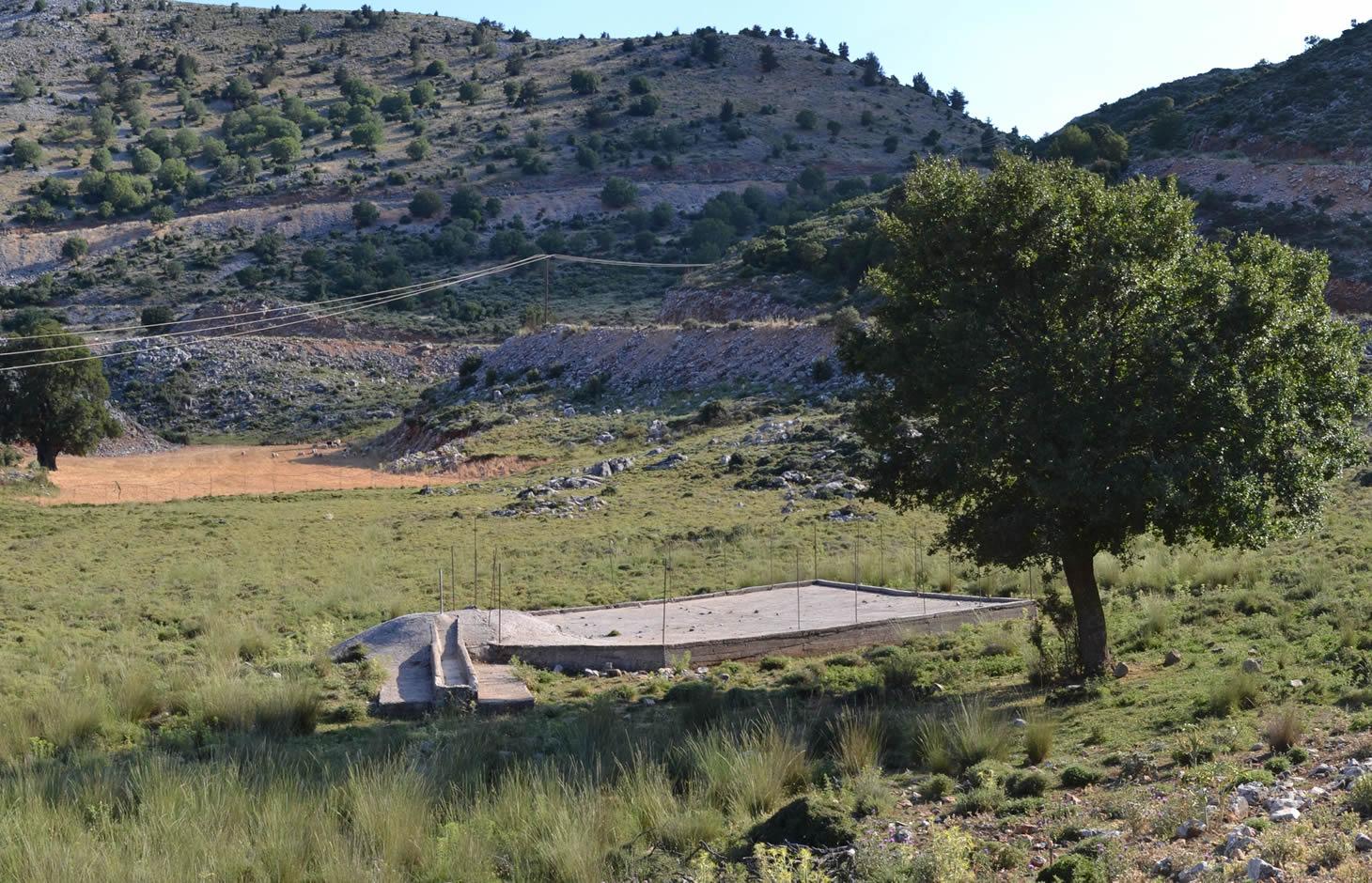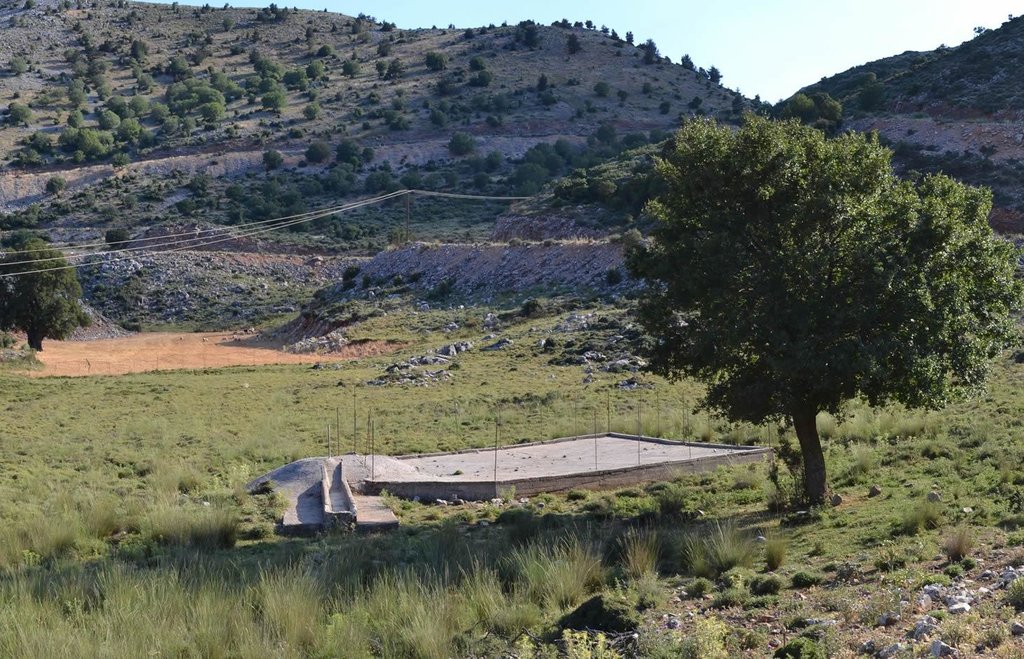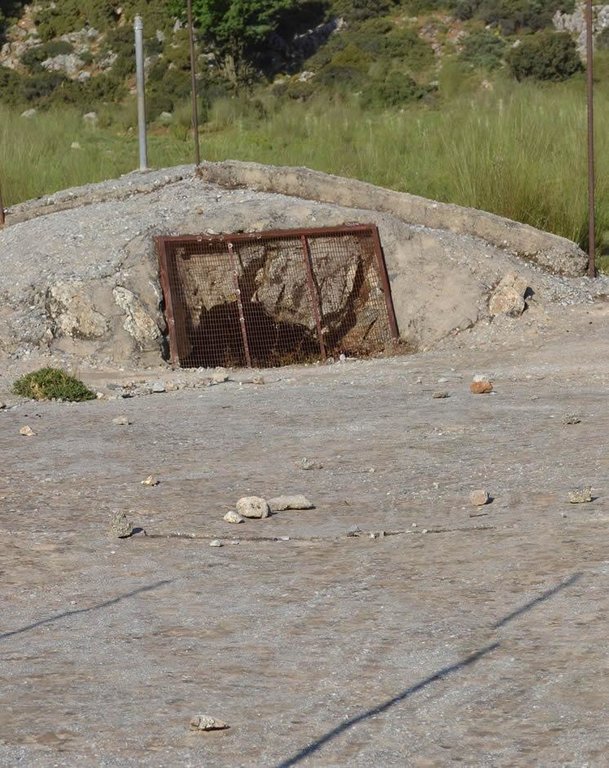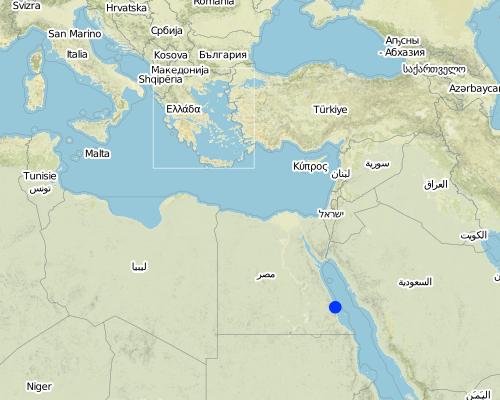Integrated water-harvesting and livestock water-point system [اليونان]
- تاريخ الإنشاء:
- تحديث:
- جامع المعلومات: Ioannis Daliakopoulos
- المحرر: –
- المُراجع: Fabian Ottiger
Συνδυασμένο σύστημα συγκομιδής ομβρίων υδάτων και ποτίσματος αιγοπροβάτων
technologies_1206 - اليونان
عرض الأقسام
توسيع الكل طي الكل1. معلومات عامة
1.2 تفاصيل الاتصال بالأشخاص الرئيسيين لمصدر المعلومات والمؤسسات المشاركة في تقييم وتوثيق التقنية
متخصص في الإدارة المستدامة للأراضي:
متخصص في الإدارة المستدامة للأراضي:
Tsanis Ioannis
tsanis@hydromech.gr
Technical University of Crete
Chania 731 00, Greece
اليونان
اسم المشروع الذي سهّل توثيق/تقييم التقنية (إذا كان ذلك على صلة)
Catastrophic shifts in drylands (EU-CASCADE)اسم المؤسسة (المؤسسات) التي سهلت توثيق/تقييم التقنية (إذا كان ذلك على صلة)
Technical University of Crete (Technical University of Crete) - اليونان1.3 الشروط المتعلقة باستخدام البيانات الموثقة من خلال WOCAT
متى تم تجميع البيانات (ميدانيا)؟:
01/06/2014
يوافق جامع المعلومات والشخص (لاشخاص) الرئيسي لمصدر المعلومات على الشروط المتعلقة باستخدام البيانات الموثقة من خلال WOCAT:
نعم
2. وصف تقنيةالإدارة المستدامي للأراضي
2.1 وصف مختصر للتقنية
تعريف التقنية:
Integration of a cement pan and collection well system for water harvesting and a trough serving as a livestock water point.
2.2 وصف تفصيلي للتقنية
الوصف:
An area of around 100 m<sup>2</sup> built out of cement or similar impermeable material forms an artificial watershed that drains into a well or tank, depending on landscape slope and system configuration. The well/tank, also made of cement to reduce losses due to infiltration, is covered in order to prevent water evaporation during the dry season. Its size depends on configuration and is ca. 40 m<sup>3</sup>. A detachable pumping system is used to draw water into a trough that is part of the permanent structure in a convenient location of the well or pan. The quality of water is maintained by keeping the collection area isolated from livestock using a removable chain-link fence placed on permanent metal poles. A grate is also installed at the opening of the well/tank to filter debris.
Purpose of the Technology: This system is installed in remote locations with poor access to fresh water. The water harvesting system collects water during the winter rains and snowfalls for use during the dry season. The trough of the system serves as a watering point for the user's livestock. This way the user can reduce the need of water transportation for his livestock, usually involving additional labor and transportation costs.
Besides the practical use of the water harvesting system, several functions are served with this installation. The existence of a source of soil moisture can cause a marked change in an otherwise very dry environment. Frequently these structures are jointly owned thus creating a sense of community among pastoralists.
Establishment / maintenance activities and inputs: Depending on initial slope, the water storage structure is designed. In relatively flat areas a well is dug and lined, whereas steeper slopes can be profited from by building part of the collection structure above ground. The later solution has a reduced cost and may also allow water extraction with natural flow. The technology can also be applied to extend the use of traditional wells by adding the rest of the structures. Exact sizing can be specified to allow storage of 10-20% over the average wet season precipitation in the area. After slope preparation, the collection structure, cement watershed and trough are constructed. The system is best established during autumn where temperature extremes that can make concrete curing difficult are less frequent. During the dry season, water can be extracted either by natural flow or a vacuum pump and channeled directly into the water point. Typically the cement structure and pumping system require little maintenance.
Natural / human environment: The harvesting system is best installed where the annual precipitation amount is sufficient but availability is hindered by seasonality, i.e. little natural storage exists and dry seasons yield little or no precipitation. The system is also most useful in remote locations with little or no access to water. Nevertheless, for the systems that require mechanical pumping, the location needs to be accessible by utility vehicle carrying relevant equipment and power supply.
2.3 صور التقنية
2.5 البلد/المنطقة/المواقع التي تم تنفيذ التقنية فيها والتي يغطيها هذا التقييم
البلد:
اليونان
المنطقة/الولاية/المحافظة:
Chania
مزيد من التفاصيل حول الموقع:
Askifou
Map
×2.6 تاريخ التنفيذ
في حالة عدم معرفة السنة بالتحديد، يرجى الإشارة إلى التاريخ التقريبي:
- منذ 10-50 سنة
2.7 إدخال التقنية
حدد كيف تم إدخال التقنية:
- من خلال المشاريع/ التدخلات الخارجية
التعليقات (نوع المشروع، الخ):
The storage of the specific water harvesting system is part of a traditional well constructed around 1870 and the rest of the structures where added during the 90s though initiatives of the municipality.
3. تصنيف تقنية الإدارة المستدامي للأراضي
3.1 الغرض الرئيسي ( الأغراض الرئيسية) للتقنية
- تحسين الإنتاج
3.2 نوع (أنواع) استخدام الأراضي الحالية حيث يتم تطبيق التقنية

أراضي الرعي
أراضي الرعي الواسع النطاق:
- الرعي المرتحل
- رعي شبه مرتحل
الأنواع والمنتجات الحيوانية الرئيسية:
Main species: Sheep/ goats
التعليقات:
Major land use problems (compiler’s opinion): precipitation seasonal variability causing water availability shortage during dry summers
Semi-nomadism / pastoralism: sheep/ goats
3.3 مزيد من المعلومات حول استخدام الأراضي
إمدادات المياه للأرض التي يتم تنفيذ التقنية عليها:
- بعلية
عدد مواسم الزراعة في السنة:
- 1
حدد:
Longest growing period in days: 298Longest growing period from month to month: 271-353
كثافة الثروة الحيوانية (إذا كانت ذات صلة):
50-100 LU /km2
3.4 مجموعةالإدارة المستدامة للأراضي التي تنتمي إليها هذه التقنية
- حصاد المياه
3.5 انتشار التقنية
التعليقات:
Total area covered by the SLM Technology is 0.03 m2.
3.6 التدابير التقنية في مجال إلادارة المستدامة للأراضي

التدابير البنيوية
- S5: السدود، الأحواض الصغيرة، البرك
- S11: غير ذلك
التعليقات:
Main measures: structural measures
Specification of other structural measures: well and watering point
3.7 الأنواع الرئيسية من تدهور الأراضي التي تناولتها التقنية

تدهور المياه
- (Ha): التجفيف
- (Hs): التغيير في كمية المياه السطحية
التعليقات:
Main type of degradation addressed: Ha: aridification
Secondary types of degradation addressed: Hs: change in quantity of surface water
Main causes of degradation: droughts
3.8 منع أو حد أو عكس تدهور الأراضي
تحديد هدف التقنية فيما يتعلق بتدهور الأراضي:
- منع تدهور الأراضي
- الحد من تدهور الأراضي
التعليقات:
Main goals: mitigation / reduction of land degradation
Secondary goals: prevention of land degradation
4. المواصفات الفنية، وأنشطة التنفيذ، والمدخلات، والتكاليف
4.1 الرسم الفني للتقنية
المؤلف:
I. Daliakopoulos
4.2 المواصفات الفنية/شروحات الرسم الفني
The collection area, lined with cement, drains into the well through the collection point. A removable chain-link fence keeps the collection area isolated from livestock. A detachable pumping system can be connected to the pump installation point in order to supply the livestock water point with water from the well.
Date: 2/9/2014
Technical knowledge required for field staff / advisors: moderate
Technical knowledge required for land users: low
Main technical functions: water harvesting / increase water supply
Structural measure: well
Depth of ditches/pits/dams (m): 5
Width of ditches/pits/dams (m): 3
Length of ditches/pits/dams (m): 3
Structural measure: collection area
Depth of ditches/pits/dams (m): 0.1
Width of ditches/pits/dams (m): 10
Length of ditches/pits/dams (m): 10
Structural measure: watering point
Depth of ditches/pits/dams (m): 0.2
Width of ditches/pits/dams (m): 1
Length of ditches/pits/dams (m): 5
Structural measure: fencing
Height of bunds/banks/others (m): 1.5
Length of bunds/banks/others (m): 40
Specification of dams/ pans/ ponds: Capacity 40m3
Catchment area: 100m2
4.3 معلومات عامة بخصوص حساب المدخلات والتكاليف
عملة أخرى/ عملة وطنية (حدد):
euro
أشر إلى سعر الصرف من الدولار الأمريكي إلى العملة المحلية (إذا كان ذا صلة): 1 دولار أمريكي =:
0,77
4.4 أنشطة التأسيس
| النشاط | نوع التدبير | التوقيت | |
|---|---|---|---|
| 1. | Field preparation | بنيوية أو هيكلية | |
| 2. | Well digging | بنيوية أو هيكلية | |
| 3. | Building of cement well cover | بنيوية أو هيكلية | |
| 4. | Laying of concrete pan for water/snow collection | بنيوية أو هيكلية | Installation |
| 5. | Installation of pumping tube | بنيوية أو هيكلية | |
| 6. | Installation of cement watering point | بنيوية أو هيكلية | |
| 7. | Fence installation | بنيوية أو هيكلية | |
| 8. | Pump acquisition | بنيوية أو هيكلية |
4.5 التكاليف والمدخلات اللازمة للتأسيس
| تحديد المدخلات | الوحدة | الكمية | التكاليف لكل وحدة | إجمالي التكاليف لكل مدخل | % من التكاليف التي يتحملها مستخدمو الأراضي | |
|---|---|---|---|---|---|---|
| العمالة | Labour | Dam | 1,0 | 2865,0 | 2865,0 | 100,0 |
| معدات | Machine use | Dam | 1,0 | 580,0 | 580,0 | 100,0 |
| مواد البناء | Chain-link fence | Dam | 1,0 | 325,0 | 325,0 | 100,0 |
| مواد البناء | Concrete | Dam | 1,0 | 3270,0 | 3270,0 | 100,0 |
| مواد البناء | Cement pipes | Dam | 1,0 | 1940,0 | 1940,0 | 100,0 |
| مواد البناء | Pum | Dam | 1,0 | 390,0 | 390,0 | 100,0 |
| إجمالي تكاليف إنشاء التقنية | 9370,0 | |||||
4.6 الصيانة/الأنشطة المتكررة
| النشاط | نوع التدبير | التوقيت/الوتيرة | |
|---|---|---|---|
| 1. | Pump maintenance | بنيوية أو هيكلية | once a year |
4.7 التكاليف والمدخلات اللازمة للصيانة/للأنشطة المتكررة (سنويًا)
| تحديد المدخلات | الوحدة | الكمية | التكاليف لكل وحدة | إجمالي التكاليف لكل مدخل | % من التكاليف التي يتحملها مستخدمو الأراضي | |
|---|---|---|---|---|---|---|
| العمالة | Labour | Dam | 1,0 | 50,0 | 50,0 | |
| إجمالي تكاليف صيانة التقنية | 50,0 | |||||
التعليقات:
Costs were calculated for the construction of a well in 2014 for an easily accessible location. Nevertheless, the specific system is built around a traditional well thus its actual cost was lower.
4.8 أهم العوامل المؤثرة على التكاليف
قدم وصفا لأهم العوامل التي تؤثر على التكاليف:
Costs mainly depend on the well/tank contraction and the accessibility of the construction area (slope, proximity to road network, etc.)
5. البيئة الطبيعية والبشرية
5.1 المناخ
هطول الأمطار السنوي
- < 250 مم
- 251- 500 ملم
- 501 - 750ملم
- 1,000-751 ملم
- 1,500-1,100 ملم
- 2,000-1,500 ملم
- 3,000-2,001 ملم
- 4,000-3,100 ملم
- > 4000 ملم
المواصفات/التعليقات على هطول الأمطار:
Winter rains
المنطقة المناخية الزراعية
- شبه رطبة
- شبه قاحلة
Thermal climate class: subtropics
5.2 طوبوغرافيا
متوسط الانحدارات:
- مسطح (0-2%)
- بسيط (3-5%)
- معتدل (6-10%)
- متدحرج (11-15%)
- تلال (16-30%)
- شديدة الانحدار(31-60%)
- فائقة الانحدار (>60%)
التضاريس:
- هضاب/سهول
- أثلام مرتفعة
- المنحدرات الجبلية
- منحدرات التلال
- منحدرات في السفوح
- قاع الوادي
المنطقة الارتفاعية:
- 100-0 متر فوق سطح البحر
- 500-101 متر فوق سطح البحر
- 1,000-501 متر فوق سطح البحر
- 1,500-1,001 متر فوق سطح البحر
- 2,000-1,501 متر فوق سطح البحر
- 2,500-2,100 متر فوق سطح البحر
- 3,000-2,501 متر فوق سطح البحر
- 4,000-3,001 متر فوق سطح البحر
- > 4000 متر فوق سطح البحر
التعليقات والمواصفات الإضافية بشأن التضاريس:
Landforms: On hill slopes configuration may differ, may not require pumping equipment
Slopes on average: Hilly (16-30%) configuration may change, may not require pump
5.3 التربة
متوسط عمق التربة:
- ضحل جدًا (0-20 سم)
- ضحلة (21-50 سم)
- متوسطة العمق (51-80 سم)
- عميقة (81-120 سم)
- عميقة جدًا (> 120 سم)
قوام التربة (التربة السطحية):
- متوسط ( طميي، سلتي)
المواد العضوية في التربة السطحية:
- منخفضة (<1%)
إذا كان متاحًا، قم بإرفاق وصف كامل للتربة أو تحديد المعلومات المتوفرة، على سبيل المثال نوع التربة، الرقم الهيدروجيني/ درجة حموضة التربة، قدرة التبادل الكاتيوني، النيتروجين، الملوحة وما إلى ذلك.
Soil fertility is low
Soil drainage/infiltration is medium
Soil water storage capacity is very low
5.4 توافر المياه ونوعيتها
منسوب المياه الجوفية:
> 50 م
توافر المياه السطحية:
ضعيف/ غير متوافر
نوعية المياه (غير المعالجة):
مياه شرب جيدة
5.5 التنوع البيولوجي
تنوع الأنواع:
- متوسط
5.6 خصائص مستخدمي الأراضي الذين يطبقون التقنية
التوجه السوقي لنظام الإنتاج:
- تجاري/سوق
الدخل من خارج المزرعة:
- 10-50% من جميع الإيرادات
المستوى النسبي للثروة:
- ضعيف
- متوسط
أفراداً أو مجموعات:
- المجموعات/ المجتمع المحلي
الجنس:
- رجال
اذكر الخصائص الأخرى ذات الصلة لمستخدمي الأراضي:
Land users applying the Technology are mainly common / average land users
Population density: < 10 persons/km2
Annual population growth: 0.5% - 1%
5.7 متوسط مساحة الأرض المملوكة أو المستأجرة من قبل مستخدمي الأراضي الذين يطبقون التقنية
- < 0.5 هكتارا
- 0.5 - 1 هكتار
- 1 -2 هكتار
- 2 - 5 هكتار
- 5 - 15 هكتار
- 15 - 50 هكتار
- 50 - 100هكتار
- 500-100 هكتار
- 1,000-500 هكتار
- 10,000-1,000 هكتار
- > 10,000 هكتار
هل يعتبر هذا نطاقًا صغيرًا أو متوسطًا أو واسعا (في إشارة إلى السياق المحلي)؟:
- على نطاق متوسط
التعليقات:
Average area of land owned or leased by land users applying the Technology: 5-15 ha, 15-50 ha, 50-100 ha
5.8 ملكية الأراضي، وحقوق استخدام الأراضي، وحقوق استخدام المياه
ملكية الارض:
- فردية، لا يوجد سند ملكية
- فردية، يوجد سند ملكية
5.9 الوصول إلى الخدمات والبنية التحتية
الصحة:
- ضعيف
- معتدل
- جيد
التعليم:
- ضعيف
- معتدل
- جيد
المساعدة التقنية:
- ضعيف
- معتدل
- جيد
العمل (على سبيل المثال خارج المزرعة):
- ضعيف
- معتدل
- جيد
الأسواق:
- ضعيف
- معتدل
- جيد
الطاقة:
- ضعيف
- معتدل
- جيد
الطرق والنقل:
- ضعيف
- معتدل
- جيد
مياه الشرب وخدمات الصرف الصحي:
- ضعيف
- معتدل
- جيد
الخدمات المالية:
- ضعيف
- معتدل
- جيد
6. الآثار والتصريحات الختامية
6.1 الآثار التي أظهرتها التقنية في الموقع
الآثار الاجتماعية والاقتصادية
الإنتاج
خطر فشل الإنتاج
إدارة الأراضي
توافر المياه ونوعيتها
توافر المياه للماشية
نوعية المياه للماشية
الدخل والتكاليف
عبء العمل
التعليقات/ حدد:
Water does not have to be transported to distant locations
الآثار الاجتماعية والثقافية
الأمن الغذائي / الاكتفاء الذاتي
التخفيف من حدة الصراع
Improved livelihoods and human well-being
التعليقات/ حدد:
Expansive grazing and the form of transhumance practiced Crete requires a huge commitment of human capital. The transportation of water or ensuring water availability between or close to grazing grounds is an essential need of the livestock, especially during dry years. This technology contributes to the reduction of workload and to rendering transhumance more manageable.
الآثار الايكولوجية
دورة المياه / الجريان السطحي
كمية المياه
حصاد / جمع المياه
التربة
رطوبة التربة
6.3 تعرض التقنية وحساسيتها لتغير المناخ التدريجي والظواهر المتطرفة/الكوارث المرتبطة بالمناخ (كما يراها مستخدمو الأراضي)
تغير مناخ تدريجي
تغير مناخ تدريجي
| الموسم | نوع التغير المناخي/ المتطرف | كيف تتعامل التقنية مع ذلك؟ | |
|---|---|---|---|
| درجة الحرارة السنوية | زيادة | جيدا |
الظواهر المتطرفة / الكوارث المرتبطة بالمناخ
الكوارث الجوية
| كيف تتعامل التقنية مع ذلك؟ | |
|---|---|
| عاصفة ممطرة محلية | جيدا |
| عاصفة هوائية محلية | جيدا |
الكوارث المناخية
| كيف تتعامل التقنية مع ذلك؟ | |
|---|---|
| جفاف | جيدا |
الكوارث الهيدرولوجية
| كيف تتعامل التقنية مع ذلك؟ | |
|---|---|
| فيضان عام (نهر) | جيدا |
العواقب الأخرى المتعلقة بالمناخ
العواقب الأخرى المتعلقة بالمناخ
| كيف تتعامل التقنية مع ذلك؟ | |
|---|---|
| انخفاض فترة النمو | جيدا |
6.4 تحليل التكلفة والعائد
كيف يمكن مقارنة العوائد نسبة لتكاليف الإنشاء (من وجهة نظر مستخدمي الأراضي)؟
عوائد قصيرة الأجل:
سلبي
عوائد طويلة الأجل:
إيجابي
كيف تتم مقارنة العوائدمع كلفة الصيانة/التكاليف المتكررة (من وجهة نظر مستخدمي الأراضي)؟
عوائد قصيرة الأجل:
إيجابي
عوائد طويلة الأجل:
إيجابي
التعليقات:
Initially, installation costs produce negative returns. Nevertheless the system requires little maintenance and the benefits emerge very soon, even after the first winter when the well has stored rain and snow water. As fuel expenses and human capital commitment for the transportation of water are significant, benefits predominate establishment costs within 2-3 years and maintenance / recurrent costs from the first year.
6.5 اعتماد التقنية
إذا كان متاحًا، قم بتحديد الكمية (عدد الأسر المعيشية و/أو المساحةالمغطاة):
3
التعليقات:
3 land user families have adopted the Technology with external material support
Comments on acceptance with external material support: The current trend is that traditional wells are converted to an integrated water harvesting system with external support from the municipality, thus foregoing the well construction costs.
There is a little trend towards spontaneous adoption of the Technology
6.7 نقاط القوة / المزايا / الفرص التي توفرها التقنية
| نقاط القوة/ المزايا/ الفرص من وجهة نظر مستخدمي الأراضي |
|---|
|
Decreases workload and costs during the dry season. How can they be sustained / enhanced? Workload and overall costs can be enhanced by increasing the density of water harvesting systems. |
| نقاط القوة/ المزايا/ الفرص من وجهة نظر جامع المعلومات أو غيره من الاشخاص الرئيسيين لمصدر المعلومات |
|---|
|
Increases water availability for livestock during the dry season, promotes sustainable grazing. How can they be sustained / enhanced? Water availability can be sustained by promoting sustainable management of other grazing practices, e.g. maintaining a healthy LU/area ratio. |
| The system is decentralised and requires little maintenance. |
الروابط والوحدات المواضيعية
توسيع الكل طي الكلالروابط
لا يوجد روابط
الوحدات المواضيعية
لا يوجد وحدات مواضيعية





